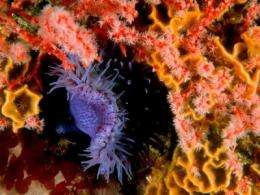Sea anemones venom key to Multiple Sclerosis treatment

(Medical Xpress) -- Sea anemones use venomous stinging tentacles to stun their prey, but one component of that venom is being used by researchers to treat the debilitating effects of Multiple Sclerosis (MS).
A new class of drug treatment is about to commence clinical trials, as the result of a decade-long investigation by Professor Ray Norton, from the Monash Institute of Pharmaceutical Sciences and his collaborators, who in the mid 1990s found a component of venom called ShK in the Caribbean sea anemone.
The researchers found ShK blocks the Kv1.3 potassium channel located in white blood cells, known as T-cells, which are known to produce nerve damage in MS, one of the most common and debilitating diseases of the nervous system.
Professor Norton has since collaborated with a team of scientists in the United States investigating potassium channels as targets for the development of novel immunosuppressive agents.
With potassium channels controlling all sorts of key functions in the human body, developing a drug without unwanted side effects would have been impossible had it not turned out that the Kv1.3 potassium channel is found only on T-cells and in the nose. Because of this limited distribution, the researchers were able to develop a highly selective immune suppressant derived from the sea anemone peptide.
Professor Norton said that by blocking the potassium channels, ShK prevented the T-cells from attacking the nervous system and causing the paralysis observed in MS patients.
"This research shows that we may be able to effectively treat the disease while protecting the immune system," Professor Norton said.
“Continuously blocking these T-cell channels with ShK should prevent further nerve damage, even after the initial onset of symptoms, including paralysis. If the clinical trials are successful, this could prove an effective treatment for MS.”
Professor Norton said ShK is one of the most potent inhibitors known for these channels.
“The next step is to find out what dose works best to treat MS and at what stage of the disease treatment should begin," Professor Norton said.
A close relative of corals and jellyfish, sea anemones spend most of their time attached to rocks on the sea floor or on coral reefs waiting for crustaceans and small fish to pass close enough to get entangled in their venom-filled tentacles.














